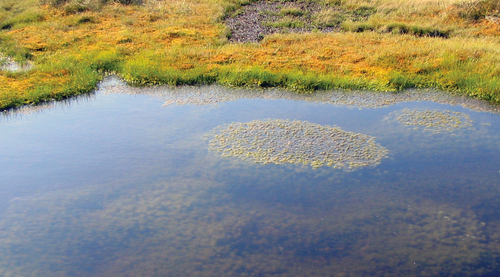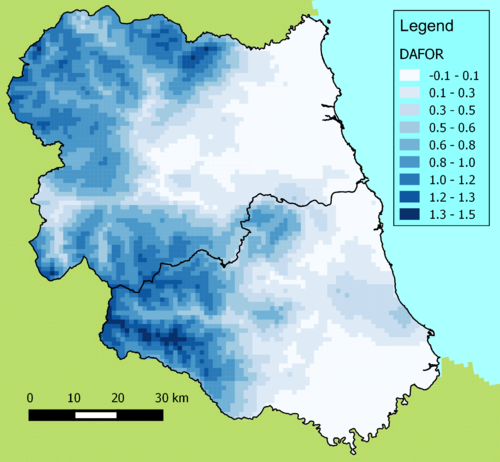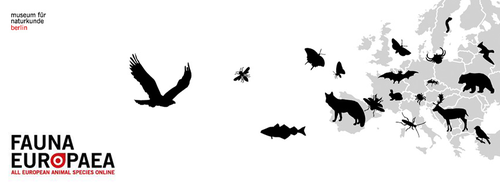EU BON partner DataONE welcomes the Program for Research on Biodiversity (PPBio) Western Amazon as its first Member Node in South America. PPBio’s Western Amazon Node data repository contains data from surveys conducted in the framework of the Research Program in Biodiversity, the Center for Integrated Studies of Biodiversity in the Amazon and partner projects.
About PPBio:
The Research Program in Biodiversity (PPBio) is structured into three components:
- Biological Collections - support and development of biological collections such as herbaria, museums and living collections;
- Biological Inventories - biodiversity surveys, collecting sites, metadata and data for long-term studies;
- Thematic Projects - developing methods for sustainable management of biodiversity and bioprospecting.
PPBio’s research is based on spatial standardization that is crucial for answering the questions raised by decision makers, the integration of biodiversity and physical sciences and on the incorporation of local people and traditional knowledge in biodiversity research and bio-prospecting. PPBio uses a flexible, standardized, modular and economical sampling method, RAPELD, which is compatible with other existing methods and a data policy which enable their datasets to be quickly made available to other researchers. PPBio has produced several free online guides to the flora and fauna of the region and the book "Biodiversity and Integrated Environmental Monitoring" which is essential reading for anyone with questions about biodiversity whether or they also intend to collect data.
A new position for "Researcher and Scientific Project Manager" is opened by the Doing it Together science (DITOs) project, running under the European Citizen Science Association (ECSA) within the H2020 framework, and led by the UCL London.
The DITOs project aims to elevate public engagement with science across Europe from passive engagement with the process of developing science to an active one.
Deadline: 23.05.2016
For more information on how to apply and requirements for this position, please download the Official Job Offer.
Applications for a Project Manager position for the Horizon 2020 project called COOP+ are now open at the University of Granada (Spain). This project aims to foster the cooperation among EU environmental research infrastructures (EISCAT, ICOS, EMSO, LifeWatch) and their international counterparts (NEON, TERN, AMERIFLUX, LBA, ILTER, OOI, AMISR, IMOS, etc.).
The Project Manager will be in contact with the project consortium on a daily basis to foster the cooperation among RIs. He/she will be responsible for communication with project partners (organizing meetings, workshops and videoconferences during the project duration, maintenance of web page). He/she will also participate in writing reports, timely production of deliverables as well as scientific outputs. He/she will join the "Laboratory of ecology" located in theAndalusian Institute for Earth System Research, at the University of Granada (Spain).
More infornation on the position, requirements and how to apply can be found in the offcial job offer.
Recommendations from the FP7-funded EU project BESAFE
Biodiversity decline is a fact, but how can society be convinced of the benefits of biodiversity for human well being and of the necessity of further protective action? The FP7 funded EU project Biodiversity and Ecosystem Services: Arguments for our Future Environment (BESAFE) addressed this challenge to produce guidance that can help improve the way we use arguments for conservation and convincingly demonstrate the value of biodiversity to decision-makers.

Credit: Rob Bugter
Two key outputs of the project are the final brochure "How to Argue for Biodiversity Conservation More Effectively: Recommendations from the BESAFE project", including key conclusions from project publications and case studies, and an interactive online tool, which can lead stakeholders to the relevant information in a few mouse clicks.
Key recommendations of BESAFE featured in these resources are:
- The success of a more integrated approach depends on stakeholder engagement. A top-down policy framework that sets goals for the protection of particular sites and species is important, but it is not enough to prevent biodiversity loss. - -- An integrated approach, seeking to 'mainstream' biodiversity concerns across all policy sectors (e.g. agriculture, forestry, water, energy, transport and urban planning) is needed.
- Promote bottom-up initiatives at the local level. All stakeholders need to be actively involved in the decision-making process, which should facilitate building trust and working towards generally agreed and accepted solutions.
- Tailor arguments to the audience. Arguments need to be framed to fit the values and goals of the audience, embracing the plurality of values attached to nature, and using appropriate language. For example, over-emphasising economic arguments could alienate people who are motivated mainly by ethical and moral concerns.
- Use positive arguments. Positive framing of arguments to emphasise benefits is often more powerful than negative framing that focuses on threats and losses. The concept of ecosystem services is useful for emphasising positive benefits, provided that it is properly explained to stakeholders.
- Use a wider range of arguments. Arguments based on the economic value of nature for humans dominate European and national policy-making, and are often seen as central to gaining high-level policy-maker support, but our results show that many decision-makers and other stakeholders also use and respond positively to ethical and moral arguments.
"We aimed to provide the essence of 4 years worth of research in an easy to read and reuse form, to maximise the potential of using the right arguments for conservation at the right time in order to successfully demonstrate the value of biodiversity to decision-makers," comments Rob Bugter, co-ordinator of the BESAFE project.
Try out the resources below:
Bugter R., Smith A.C. and the BESAFE consortium. 2015. How to argue for biodiversity conservation more effectively. Recommendations from the BESAFE project. Pensoft Publishers, Sofia, 26 pp. Available at: http://www.
BESAFE web tool available at: http://tool.
The Faculty of Geo-Information Science and Earth Observation (ITC) at the University of Twente has recently launched an investment programme to strengthen its international academic fields. For 11 pioneering-multidisciplinairy projects a PhD-position is made available, three of them already are filled in. The Department of Natural Resources (NRS) specialises in advanced spatial and temporal analysis and technique development for the environment as well as sustainable agriculture.
Job Description:
The aim of this PhD project is to develop a cloud based artificial neural network for processing large remotely sensed data sets in order to generate essential biodiversity variables (as defined by Pereira et al. (2013) and Skidmore et al. (2015)). The PhD candidate, in combination with supervisors and programming support, will develop innovative artificial intelligence techniques for estimating biodiversity variables using massive cloud based data sets of satellite remotely sensed, in situ and ancillary data. Potential candidate biodiversity variables to be retrieved from satellite remote sensing include pertinent indicators of ecosystem function, ecosystem structure and species traits. The research will result in a PhD thesis.
For more information visit the official job offer.
- Assistant Programme Officer – Marine Digital Products (AD 916) Deadline: 5th February 2016
- Assistant Programme Officer (AD 922) Deadline: 5th February 2016
The Tropical Ecology Assessment and Monitoring (TEAM) network has the aim to measure and compare plants, terrestrial mammals, ground-dwelling birds and climate using a standard methodology in a range of tropical forests, from relatively pristine places to those most affected by people. TEAM currently operates in sixteen tropical forest sites across Africa, Asia and Latin America supporting a network of scientists committed to standardized methods of data collection to quantify how plants and animals respond to pressures such as climate change and human encroachment.
A recent TEAM network paper published in PLOS Biology deals with the standartization of methods in assessing biodiversity trends in tropical forest protected areas.
Abstract:
A new paper "Combining internal and external motivations in multi-actor governance arrangements for biodiversity and ecosystem services" published in the journal Environmental Science & Policy looks at ways to motivate actions for biodiversity conservation and ecosystem services provision. The paper is a result of the EU FP7 funded project BIOMOT.
This paper analyses the possibility of building a mutually supportive dynamics between internally and externally motivated behaviour for biodiversity conservation and ecosystem services provision. To this purpose a face to face survey amongst 169 key actors of 34 highly successful and prominent biodiversity arrangements in seven EU countries was conducted. The main finding of the paper is the feasibility of combining inherently intrinsically motivated behaviours (providing enjoyment, pleasure from experimentation and learning, aesthetic satisfaction) and internalized extrinsic motivations (related to the identification with the collective goals of conservation policy) through a common set of governance features. Successful initiatives that combine internal and external motivations share the following features: inclusive decision making processes, a broad monitoring by "peers" beyond the core staff of the initiatives, and a context that is supportive for the building of autonomous actor competences. These findings are in line with the psycho-sociological theory of motivation, which shows the importance of a psycho-social context leading to a subjective perception of autonomy and a sense of competence of the actors.
Original Source:
Tom Dedeurwaerdere, Jeroen Admiraal, Almut Beringer, Flavia Bonaiuto, Lavinia Cicero, Paula Fernandez-Wulff, Janneke Hagens, Juha Hiedanpää, Paul Knights, Erica Molinario, Paolo Melindi-Ghidi, Florin Popa, Urban Šilc, Nathalie Soethe, Tiina Soininen, Jose Luis Vivero, Combining internal and external motivations in multi-actor governance arrangements for biodiversity and ecosystem services, Environmental Science & Policy, Volume 58, April 2016, Pages 1-10, ISSN 1462-9011, http://dx.doi.org/10.1016/j.envsci.2015.12.003
A recently completed benchmark survey of common plants provides a comprehensive dataset of vascular plant diversity and abundance in South Northumberland and Durham, contributing an additional 35,000 observations to the 200,000 observations collected by local recorders since the turn of the millennium.
Apart from contributing an updated inventory of vascular plant diversity, the survey is intended to be used as a reference point with which to identify change in the countryside and study the drivers of biodiversity change in the North-east of England.
Changes in the abundance of rare species have little impact on other species, but change in the abundance of common species can have cascading effects on whole ecosystems. The new survey provides a solid foundation that can be used to qualify the abundance of common species and compare against previous and future studies.

The distribution of heather predicted from the common plant survey data. This is one of the region's most characteristic species and one that many other organisms rely upon for food and cover.
The survey was part of the North-East Common Plants Survey Project, conducted over four years and required volunteers to go to various places. Some surveyed post-industrial brown-field sites, while others walked for miles across bleak moorland to reach sites high in the hills. Although these moors are arguably wilder and natural, the industrial wastelands turn out to be far more biodiverse.
Botanical surveying continues in the region despite the end of the project. Volunteers continue to monitor rare plants in the region and are currently working towards the next atlas of Britain and Ireland, coordinated by the Botanical Society of Britain and Ireland.
This survey is also among the first one to make use of the Integrated Publishing Toolkit (IPT) functionality, jointly developed by EU BON and GBIF, that allows the easy export and exposure of datasets to maximize their discoverability and reuse. The survey was published in the Biodiversity Data Journal, providing easy and streamlined publication of GBIF data via a variety of newly introduced plugins.
Original Source:
Groom Q, Durkin J, O'Reilly J, Mclay A, Richards A, Angel J, Horsley A, Rogers M, Young G (2015) A benchmark survey of the common plants of South Northumberland and Durham, United Kingdom. Biodiversity Data Journal 3: e7318. doi: 10.3897/BDJ.3.e7318
A new article published in the Journal of Marine Science and Engineering looks at how Aphia, the core platform that underpins the World Register of Marine Species (WoRMS), can Serve the taxonomic community and the field of biodiversity informatics.
Abstract
The Aphia platform is an infrastructure designed to capture taxonomic and related data and information, and includes an online editing environment. The latter allows easy access to experts so they can update the content of the database in a timely fashion. Aphia is the core platform that underpins the World Register of Marine Species (WoRMS) and its more than 80 related global, regional and thematic species databases, but it also allows the storage of non-marine data. The content of Aphia can be consulted online, either by individual users or via machine-to-machine interactions. Aphia uses unique and stable identifiers for each available name in the database through the use of Life Science Identifiers (LSIDs). The system not only allows the storage of accepted and unaccepted names, but it also documents the relationships between names. This makes it a very powerful tool for taxonomic quality control, and also allows the linking of different pieces of information through scientific names, both within the Aphia platform and in relation to externally hosted databases. Through these LSIDs, Aphia has become an important player in the field of (marine) biodiversity informatics, allowing interactions between its own taxonomic data and e.g., biogeographic databases. Some applications in the field of biodiversity informatics encompass the coupling of species traits and taxonomy, as well as the creation of diverse, expert validated data products that can be used by policy makers, for example. Aphia also supplies (part of) its content to other data integrators and the infrastructure can be used to host orphan databases in danger of being lost.
Original Source: http://www.mdpi.com/2077-1312/3/4/1448/htm
The Museum für Naturkunde and the Botanic Garden and Botanical Museum are honored to be hosting the 31st Annual Meeting of the Society for the Preservation of Natural History Collections (SPNHC) as well as the 2nd International Conference on Biodiversity Biobanking of the Global Genome Biodiversity Network (GGBN) in Berlin from June, 20 to June, 25, 2016. The conferences will be held in parallel at the andel’s Hotel Berlin, Landsberger Allee.
- SPNHC conference web site: http://www.spnhc2016.berlin/, conference theme: "Green Museum – How to practice what we preach?"
- GGBN conference web site: https://meetings.ggbn.org/conference/ggbn/2016/index, conference theme: "Meeting the Challenge: How to Preserve a Cross-Section of the Tree of Life"
The registration for both conferences is now open. Please check the conference web sites for information on the conference program, field trips, social events, accommodation, registration and abstract submission. All social events and field trips as well as the opening session on Tuesday are joint events for attendees of both conferences. During lunch and coffee breaks one will have the chance to visit the vendor booths and chat with attendees of both conferences. The sessions of both conferences cover complementary topics to avoid duplications.
A new special issue titled "Connecting the Dots: Integrating Biodiversity Observations to Better Track the CBD 2020 Targets" looks at Biodiversity Observatios and the ways that can be integrated into the CBD 2020 targers, for better results in biodiversity conservation.
The issue, where a number of GEO BON partners are authors, explores a wide variety of aspects of Biodiveristy Observations, including data management, integration of in-stiu data, the roles and contricutions of BONs, contextualization with the UN's Sustainable Developmen Goals, and many more.
For more information and to see what is included in the Special Issue, click here.
Europe's main zoological taxonomic index - Fauna Europaea presents its updated and modernized website at http://www.fauna-eu.org/. Scientific names and distributions of all living, currently known, multicellular, European land and freshwater animal species are available in one authoritative database.Fauna Europaea offers key information on:
- Taxonomical index for European land and freshwater species
- Information on the geographical distribution of many species
- Database on taxonomic experts in Europe
- References on literature of European species taxonomy and distribution
- A browsable taxon tree

Fauna Europaea provides access to its rich and quality-checked data via this public web portal that also links to other key biodiversity services. It is installed as a taxonomic backbone in a wide range of biodiversity services and actively contributes to biodiversity informatics innovations in various initiatives and EC programs. Fauna Europaea started in 2000 as an EC funded FP5 project and provides a unique taxonomic reference for many user-groups such as scientists, governments, industries, nature conservation communities and educational programs. Fauna Europaea was formally accepted as an INSPIRE standard for Europe, as part of the European Taxonomic Backbone established in PESI. Today it is hosted by the Museum für Naturkunde in Berlin.




 RSS news
RSS news













